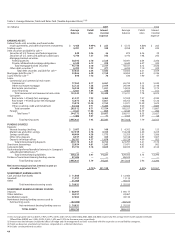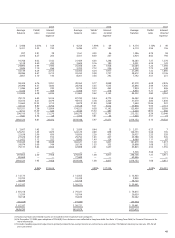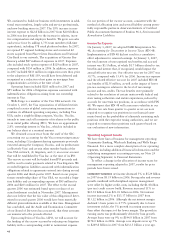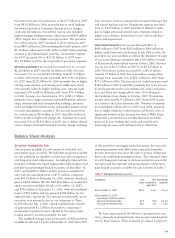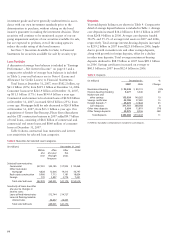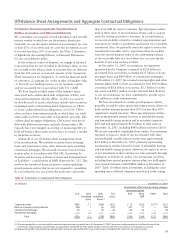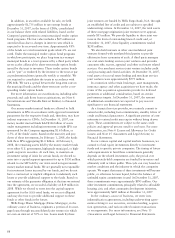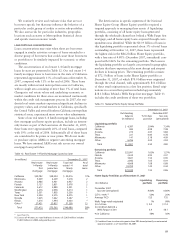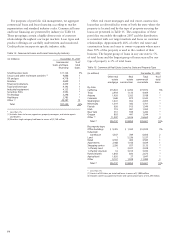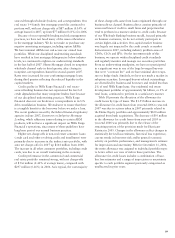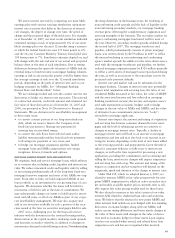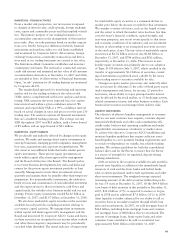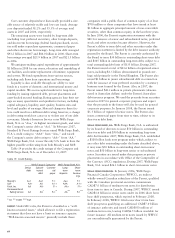Wells Fargo 2007 Annual Report Download - page 57
Download and view the complete annual report
Please find page 57 of the 2007 Wells Fargo annual report below. You can navigate through the pages in the report by either clicking on the pages listed below, or by using the keyword search tool below to find specific information within the annual report.54
Our business units and the office of the Chief Credit
Officer periodically review all credit risk portfolios to ensure
that the risk identification processes are functioning properly
and that credit standards are followed. Business units con-
duct quality assurance reviews to ensure that loans meet
portfolio or investor credit standards. Our loan examiners
in risk asset review and internal audit independently review
portfolios with credit risk, monitor performance, sample
credits, review and test adherence to credit policy and
recommend/require corrective actions as necessary.
Our primary business focus on middle-market commercial,
residential real estate, auto, credit card and small consumer
lending, results in portfolio diversification. We assess loan
portfolios for geographic, industry or other concentrations
and use mitigation strategies, which may include loan sales,
syndications or third party insurance, to minimize these
concentrations, as we deem appropriate.
In our commercial loan, commercial real estate loan and
lease financing portfolios, larger or more complex loans are
individually underwritten and judgmentally risk rated. They
are periodically monitored and prompt corrective actions are
taken on deteriorating loans. Smaller, more homogeneous
commercial small business loans are approved and moni-
tored using statistical techniques.
Retail loans are typically underwritten with statistical
decision-making tools and are managed throughout their life
cycle on a portfolio basis. The Chief Credit Officer establishes
corporate standards for model development and validation to
ensure sound credit decisions and regulatory compliance and
approves new model implementation and periodic validation.
Residential real estate mortgages are one of our core
products. We offer a broad spectrum of first mortgage and
junior lien loans that we consider mostly prime or near
prime. These loans are almost entirely secured by a primary
residence for the purpose of purchase money, refinance, debt
consolidation, or home equity loans. We do not make or
purchase option adjustable-rate mortgage products (option
ARMs) or variable-rate mortgage products with fixed payment
amounts, commonly referred to within the financial services
industry as negative amortizing mortgage loans, as we believe
these products rarely provide a benefit to our customers.
We originate mortgage loans through a variety of sources,
including our retail sales force and licensed real estate bro-
kers. We apply consistent credit policies, borrower documen-
tation standards, Federal Deposit Insurance Corporation
Improvement Act of 1991 (FDICIA) compliant appraisal
requirements, and sound underwriting, regardless of applica-
tion source. We perform quality control reviews for third
party originated loans and actively manage or terminate
sources that do not meet our credit standards. Specifically,
during 2007 we stopped originating first and junior lien resi-
dential mortgages where credit performance had deteriorated
beyond our expectations, especially recent vintages of high
combined loan-to-value home equity loans sourced through
third party channels.
We believe our underwriting process is well controlled
and appropriate for the needs of our customers as well as
investors who purchase the loans or securities collateralized
by the loans. We only approve applications and make loans
if we believe the customer has the ability to repay the loan or
line of credit according to all its terms. A small portion of
borrower selected stated income loans originated from third
party channels produced unacceptable performance in our
Home Equity portfolio. We have tightened our bank-selected
reduced documentation requirements as a precautionary
measure and substantially reduced third party originations
due to the negative trends experienced in these channels.
Appraisals are used to support property values.
In the mortgage industry, it has been common for consumers,
lenders, and servicers to purchase mortgage insurance, which
can enhance the credit quality of the loan for investors and
serves generally to expand the market for home ownership.
In our servicing portfolio, certain of the loans we service
carry mortgage insurance, based largely on the requirements
of investors, who bear the ultimate credit risk. Within our
$1.5 trillion servicing portfolio, we service approximately
$115 billion of loans that carry approximately $25 billion of
mortgage insurance coverage purchased from a group of
mortgage insurance companies that are rated AA or higher
by one or more of the major rating agencies. Should any of
these companies experience a downgrade by one or more of
the rating agencies, investors may be exposed to a higher
level of credit risk. In this event, as servicer, we would work
with the investors to determine if it is necessary to obtain
replacement coverage with another insurer. Our mortgage
servicing portfolio consists of over 90% prime loans and we
continue to be among the highest rated loan servicers for res-
idential real estate mortgage loans, based on various servic-
ing criteria. The foreclosure rate in our mortgage servicing
portfolio was only 0.88% at year-end 2007.
Similarly, we obtained approximately $2 billion of mortgage
insurance coverage for certain loans that we held for investment
or for sale at December 31, 2007. In the event a mortgage
insurer is unable to meet its obligations on defaulted loans in
accordance with the insurance contract, we might be exposed
to higher credit losses if replacement coverage on those loans
cannot be obtained. However, approximately one-third of the
coverage related to the debt consolidation nonprime real estate
1-4 family mortgage loans held by Wells Fargo Financial, which
have had a low level of credit losses (0.31% loss rate (annualized)
in fourth quarter 2007 for the entire debt consolidation
portfolio). The remaining coverage primarily related to
prime real estate 1-4 family mortgage loans, primarily high
quality ARMs for our retail and wealth management
customers, which also have had very low loss rates.
Each business unit regularly completes asset quality fore-
casts to quantify its intermediate-term outlook for loan losses
and recoveries, nonperforming loans and market trends. To
make sure our overall loss estimates and the allowance for
credit losses is adequate, we conduct periodic stress tests.
This includes a portfolio loss simulation model that simu-
lates a range of possible losses for various sub-portfolios
assuming various trends in loan quality, stemming from
economic conditions or borrower performance.


